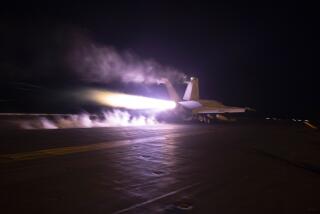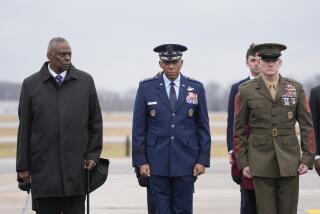British, French attack helicopters en route to Libya
British and French attack helicopters are headed to Libya in an escalation of the role some Western governments plan to play in the fighting between forces loyal to Moammar Kadafi and rebels seeking his ouster, according to a French official and media reports Monday.
French Foreign Minister Alain Juppe told reporters in Brussels that the helicopters would provide more precision than fighter jets as the West enforces a United Nations mandate to protect Libyan civilians. The aircraft will not be used to land troops, Juppe said.
“Our strategy is to step up the military pressure over the next few weeks but at the same time to make progress on the road to a political solution,” Juppe said.
Meanwhile, in the most intense bombardment to date on the Libyan capital, more than a dozen explosions rocked Tripoli early Tuesday, lighting up the night and sending plumes of black smoke into the sky. Libyan authorities said three civilians were killed and 150 injured in what NATO described as strikes on a vehicle storage facility next to Kadafi’s Bab Azizia complex.
According to the French daily newspaper Le Figaro, the French warship Tonnerre left southern France on May 17 with 12 helicopters on board. Britain’s Guardian newspaper reported that additional helicopters would be based on the Royal Navy amphibious assault ship Ocean. Britain’s Sky News reported that the government would send 12 helicopters for the Libyan campaign.
Officials with the North Atlantic Treaty Organization, which took over control of the West’s overall mission in late March, said they were aware that France had deployed a ship carrying attack helicopters but that the aircraft were not under the alliance’s command.
“At this stage, we have heard that they have got a ship with helicopters in the Mediterranean,” said a NATO spokesman. “They’re not part of us.”
The French and British may plan to conduct their own operations using attack helicopters in Libya, separate from the daily airstrikes carried out by fighter jets and U.S. Predator drones under NATO command.
In London, British Foreign Secretary William Hague declined to comment, while U.S. Secretary of State Hillary Rodham Clinton said of the reported French action: “We would welcome any further commitments they might make.”
Libyan Deputy Foreign Minister Khaled Kaim said authorities in Tripoli were reviewing the reports of the helicopter deployment.
Since the beginning of the Libya operation, some NATO members have stationed a small number of ships and other military assets near Libya that are under their own control. The U.S., for example, kept the Kearsarge, an amphibious assault ship, under its own control early in the mission. In March, helicopters from the vessels helped rescue two U.S. Marine pilots who ejected from an F-15E fighter jet that crashed because of mechanical problems.
Last month, Lt. Gen. Charles Bouchard, the Canadian officer who commands the NATO operation in Libya, said he hoped countries conducting their own operations in Libya would coordinate with the Western alliance. But the NATO spokesman said he could not say whether France and Britain had promised to do so if they conduct helicopter attacks.
Experts called such a deployment a potentially risky ramping-up of a Western-led military operation. Kadafi has managed to stay in power amid a withering aerial assault from jet fighters and U.S. drones, some targeting his compound in Tripoli.
“It’s a very significant escalation,” said Shashank Joshi, an analyst with the Royal United Services Institute, a London-based defense and security think tank.
Helicopters are much more vulnerable to ground fire than the high-altitude fighter jets currently operating in the Libyan theater. Moreover, their deployment could further anger Russia and other nations, which fear that the North Atlantic Treaty Organization has already exceeded its mandate to protect Libyan civilians.
But helicopters could boost alliance firepower substantially, possibly helping to break the combat stalemate in the North African nation.
Unlike jet fighters, helicopters can carry out precision attacks in places such as the beleaguered coastal city of Misurata, where rebels have been battling regime troops for weeks. Another potential target is the regime-held oil town of Port Brega, the easternmost coastal city still in government hands, where Kadafi loyalists have repelled rebel thrusts from the city of Ajdabiya, 50 miles to the east.
France, the United States and other nations have insisted that Kadafi step down after more than four decades in power. Kadafi has refused and has instead called for negotiations, only to be rebuffed. The Western nations have denied targeting Kadafi, despite several strikes on his Tripoli compound and a NATO statement last week that the Libyan leader “has gone into hiding.”
In a statement late Monday, a British Defense Ministry spokesman said: “As with any military campaign, we are constantly reviewing our options alongside allies to enhance the capabilities available to NATO in support of UNSCR 1973,” a reference to the United Nations resolution.
Also Monday, the most senior U.S. diplomat to visit the de facto rebel capital of Benghazi arrived for talks with opposition leaders.
“We are here for the long term and what we can offer is support to Libyan institutions and the economy,” said Jeffrey Feltman, assistant secretary of State for Near Eastern Affairs, Reuters reported. “We will be here to support you all the way.”
Times staff writers David S. Cloud in Washington and Janet Stobart in London contributed to this report.
More to Read
Start your day right
Sign up for Essential California for news, features and recommendations from the L.A. Times and beyond in your inbox six days a week.
You may occasionally receive promotional content from the Los Angeles Times.





